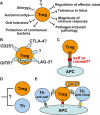How do regulatory T cells work?
- PMID: 19751267
- PMCID: PMC2784904
- DOI: 10.1111/j.1365-3083.2009.02308.x
How do regulatory T cells work?
Abstract
CD4(+) T cells are commonly divided into regulatory T (Treg) cells and conventional T helper (Th) cells. Th cells control adaptive immunity against pathogens and cancer by activating other effector immune cells. Treg cells are defined as CD4(+) T cells in charge of suppressing potentially deleterious activities of Th cells. This review briefly summarizes the current knowledge in the Treg field and defines some key questions that remain to be answered. Suggested functions for Treg cells include: prevention of autoimmune diseases by maintaining self-tolerance; suppression of allergy, asthma and pathogen-induced immunopathology; feto-maternal tolerance; and oral tolerance. Identification of Treg cells remains problematic, because accumulating evidence suggests that all the presently-used Treg markers (CD25, CTLA-4, GITR, LAG-3, CD127 and Foxp3) represent general T-cell activation markers, rather than being truly Treg-specific. Treg-cell activation is antigen-specific, which implies that suppressive activities of Treg cells are antigen-dependent. It has been proposed that Treg cells would be self-reactive, but extensive TCR repertoire analysis suggests that self-reactivity may be the exception rather than the rule. The classification of Treg cells as a separate lineage remains controversial because the ability to suppress is not an exclusive Treg property. Suppressive activities attributed to Treg cells may in reality, at least in some experimental settings, be exerted by conventional Th cell subsets, such as Th1, Th2, Th17 and T follicular (Tfh) cells. Recent reports have also demonstrated that Foxp3(+) Treg cells may differentiate in vivo into conventional effector Th cells, with or without concomitant downregulation of Foxp3.
Figures

Similar articles
-
Identity and Diversity of Human Peripheral Th and T Regulatory Cells Defined by Single-Cell Mass Cytometry.J Immunol. 2018 Jan 1;200(1):336-346. doi: 10.4049/jimmunol.1701025. Epub 2017 Nov 27. J Immunol. 2018. PMID: 29180490
-
Induction of antigen specific CD4(+)CD25(+)Foxp3(+)T regulatory cells from naïve natural thymic derived T regulatory cells.Int Immunopharmacol. 2015 Oct;28(2):875-86. doi: 10.1016/j.intimp.2015.03.049. Epub 2015 Apr 13. Int Immunopharmacol. 2015. PMID: 25882104
-
Mechanisms of human FoxP3+ Treg cell development and function in health and disease.Clin Exp Immunol. 2019 Jul;197(1):36-51. doi: 10.1111/cei.13290. Epub 2019 Apr 1. Clin Exp Immunol. 2019. PMID: 30864147 Free PMC article. Review.
-
Developmental plasticity of Foxp3+ regulatory T cells.Curr Opin Immunol. 2010 Oct;22(5):575-82. doi: 10.1016/j.coi.2010.08.004. Epub 2010 Sep 9. Curr Opin Immunol. 2010. PMID: 20829012 Review.
-
Identification of a human Th1-like IFNγ-secreting Treg subtype deriving from effector T cells.J Autoimmun. 2012 Dec;39(4):377-87. doi: 10.1016/j.jaut.2012.06.004. Epub 2012 Jul 22. J Autoimmun. 2012. PMID: 22824211
Cited by
-
Treatment of Intestinal Inflammation With Epicutaneous Immunotherapy Requires TGF-β and IL-10 but Not Foxp3+ Tregs.Front Immunol. 2021 Feb 26;12:637630. doi: 10.3389/fimmu.2021.637630. eCollection 2021. Front Immunol. 2021. PMID: 33717186 Free PMC article.
-
A review of CD4+ T cell differentiation and diversity in dogs.Vet Immunol Immunopathol. 2024 Sep;275:110816. doi: 10.1016/j.vetimm.2024.110816. Epub 2024 Aug 21. Vet Immunol Immunopathol. 2024. PMID: 39173398 Review.
-
Effects of the In Ovo and Dietary Supplementation of L-Ascorbic Acid on the Growth Performance, Inflammatory Response, and Eye L-Ascorbic Acid Concentrations in Ross 708 Broiler Chickens.Animals (Basel). 2022 Sep 27;12(19):2573. doi: 10.3390/ani12192573. Animals (Basel). 2022. PMID: 36230314 Free PMC article.
-
T regulatory cells: Achilles' heel of Mycobacterium tuberculosis infection?Immunol Res. 2015 Jul;62(3):386-98. doi: 10.1007/s12026-015-8654-0. Immunol Res. 2015. PMID: 25948475 Review.
-
Unraveling and Harnessing the Immune Response at the Cell-Biomaterial Interface for Tissue Engineering Purposes.Adv Healthc Mater. 2024 Jul;13(17):e2301939. doi: 10.1002/adhm.202301939. Epub 2024 Apr 5. Adv Healthc Mater. 2024. PMID: 38217464 Free PMC article. Review.
References
-
- Gershon RK, Cohen P, Hencin R, Liebhaber SA. Suppressor T cells. J Immunol. 1972;108:586–90. - PubMed
-
- Moller G. Do suppressor T cells exist? Scand J Immunol. 1988;27:247–50. - PubMed
-
- Sakaguchi S, Wing K, Miyara M. Regulatory T cells – a brief history and perspective. Eur J Immunol. 2007;37(Suppl. 1):S116–23. - PubMed
Publication types
MeSH terms
Substances
LinkOut - more resources
Full Text Sources
Other Literature Sources
Research Materials

